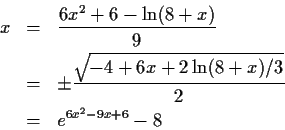


So we will use the following rule, each iterator which is a sum of a polynomial part and a non polynomial will be written as p(x) = F(x). Each iteration consists of evaluating F(xi) and then solving the polynomial p(x)-F(xi) = 0. Treating the polynomial part as a single function of x will decrease the number of occurrences of x on the rhs, and hence improve our iterators.